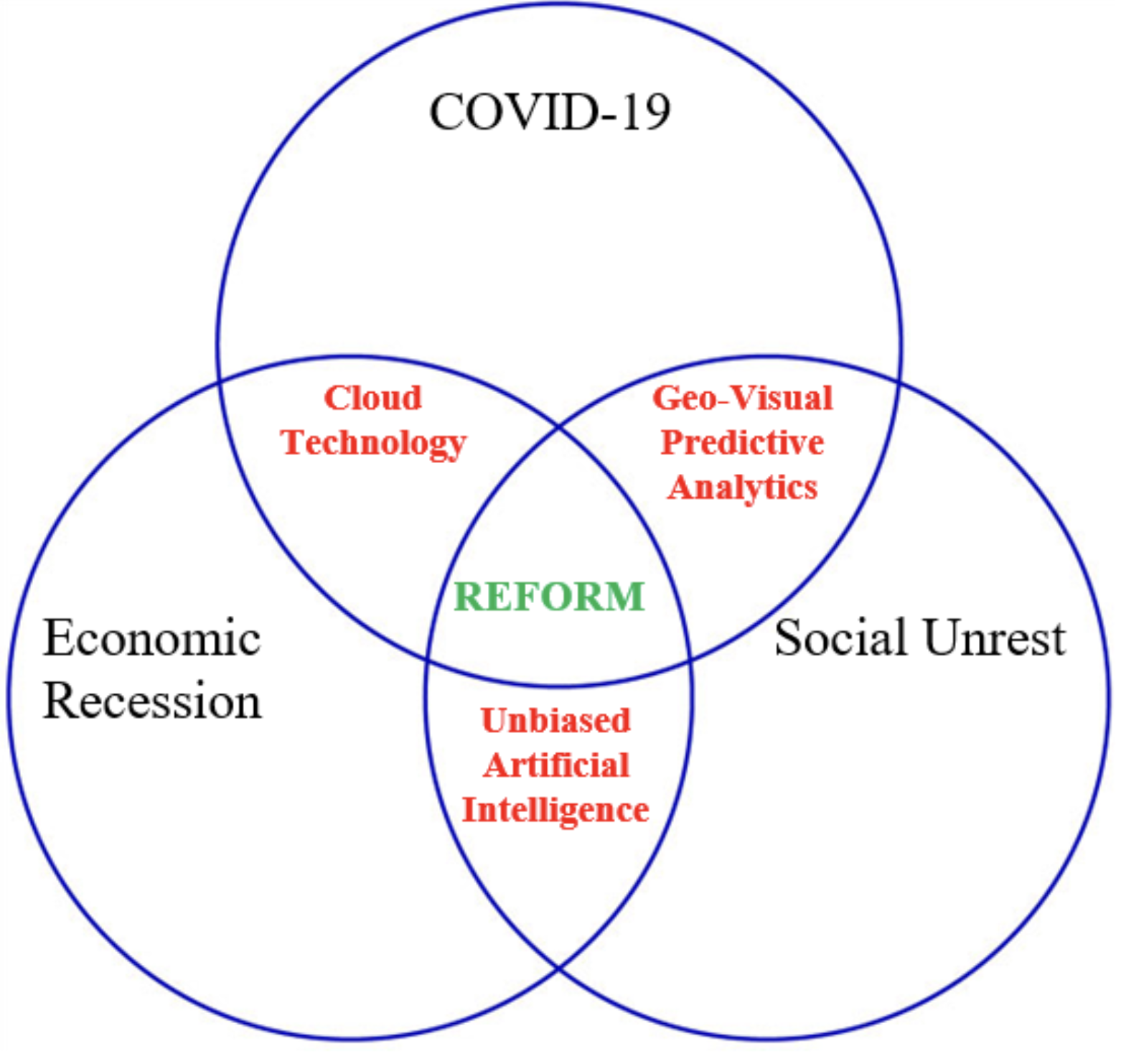
New GovTech technologies will accelerate local government reform and service levels due to the lasting impacts of COVID-19 and social unrest.
Three Events Creating Pressure for Local Government Reform
In my conversations with public-sector leaders across the country, I hear real urgency—and a fair amount of anxiety—about the need to transform government services. At the national, state, and city levels, governments know they must find new ways to meet the expectations of citizens, many of whom are increasingly discontented.
Often governments must also provide “more for less” in an environment of fiscal constraint, and myriad forces that trigger government transformations make their task more challenging.
Up until recently, about half of all public sector transformations had more than one trigger. Events provoking transformations included: outdated practices, change in organization’s leadership, need to reduce debt or deficit, change in political mandate, major performance failure, media and public pressure, and external shock.
COVID-19, economic recession, and social unrest have just pulled the trigger on each of these, and we will see a rapid acceleration of government reform!
The economic recession resulting from the COVID-19 quarantine accelerated government procurement of cloud technologies to deliver remote services to citizens that could not come to city hall, or for workers who could not be deployed in the field. Social unrest puts the spotlight on the need for geo-predictive analytics to deploy resources that preserve the health, safety, and welfare of cities and counties. And finally, when the economic recession hit the most disadvantaged, precipitating social unrest because of racial injustice, that targeted the need for unbiased algorithms in artificial intelligence tools.
And that is the reason for this blog. I want to highlight how GovTech cloud technologies, that are intelligent, unbiased, and using geo-predictive analytics, will transform local government. We will witness an acceleration in virtual city halls that deliver targeted government services and use multi-disciplinary mobile intervention teams relying on efficient, effective, strategic, and unbiased artificial intelligence.
The New Face of Government
Cloud Technology
Cloud technology is everywhere, and the importance and impact it is having on local government services is profound!
By leveraging the cloud, local government can become more efficient in its use of technology and can innovate more quickly and effectively to advance its mission. Cloud technology creates value for local governments by automating systems, efficiently collecting data (and lots of data), and executing controls on business processes, while connecting people, enforcing regulations, and analyzing data.
People want to see their local government working not as bureaucrats, but as a responsive provider of essential services. Cloud computing is being embraced by local governments because it enhances service delivery to constituents. Here are five benefits that local governments can get from using the cloud:
- Flexible – A flexible service delivery model is essential for enabling the agility, responsiveness, and innovation needed for citizen satisfaction of local government services. The cloud offers flexibility in the way that the local government handles many situations. For example, during the COVID crisis, virtual permitting, construction inspections, electronic plan reviews, remote budgeting, business licensing, and virtual code enforcement overcame quarantine mandates and allowed for continuity of governmental services.
- Efficient – With tight budgets, it does not make sense for local governments to make big changes in technology that may need to be changed again. Cloud computing offers a low-cost way to take advantage of current technology. A cloud-based business licensing system can permit online application submittals and payments, automate renewals, and allow for contactless mobile inspections.
- Effective – The cloud streamlines government services by connecting departments and providing everyone access to the information to complete a service request, work order, or budget submission. Instead of running around to multiple departments and people to find out something or to get something done, the cloud makes it a one-stop government shop. When local governments and the people they serve are connected to the cloud, it allows the government and constituents to work together rather than in silos.
- Connective – Cloud communications make it easier to share information. It allows for collaboration on projects. All of these things can be done without having to gather large groups of people together to make a decision. Instead, cloud computing allows for multiple ways for everyone to work together, including teleconferencing, video conferencing, instant messaging, email, and document sharing. This will increase the productivity of everyone involved in the local government.
- Economic – Cutting budgets is a popular theme, but no one wants to lose the services that the local government offers, and no one wants to pay more taxes. Cloud computing allows a local government to cut costs without giving anything up. In fact, the government can actually get more by spending less with cloud computing. From lower energy costs through energy efficiency to lower costs for storage of information to increased productivity of government employees to lower costs for communication equipment, cloud computing gives governments plenty of fiscal flexibility.
Geovisual Predictive Analytics
Predictive analytics is the use of data, statistical algorithms, and machine learning techniques to identify the likelihood of future outcomes based on historical data. The goal is to go beyond knowing what has happened to providing a best assessment of what will happen in the future.
Geovisual analytics refers to the science of analytical reasoning with spatial information as facilitated by interactive visual interfaces. It is distinguished by its focus on novel approaches to analysis rather than novel approaches to visualization or computational methods alone. As a result, geovisual analytics is usually grounded in real-world problem solving contexts.
The merging of these two analytical models is geovisual predictive analytics, which is a new computational approach to identify or predict patterns with visual interfaces to geographic data. Geovisual predictive analytics enable local government staff to work more proactively with limited resources. The objective of the output from analysis is to develop effective strategies for addressing governmental health, safety, and welfare concerns. However, it must be understood at all levels that applying geovisual predictive analytics is not equivalent to finding a crystal ball. For local government strategies to be considered effective, it must produce tangible results.
Geovisual predictive analytics synthesizes the following four broad categories:
1. Where are the individuals within the local government geography that need local government services?
2. When during the day or night will individuals need local government services?
3. Who are the people that require local government services?
4. What local government services should be provided to individuals at the time and place that they are needed?
Geovisual predictive analytics tools have been developed for a variety of problem scenarios, such as crisis management, policing, vegetation management, and disease epidemiology. Looking ahead, the emergence of new spatial data sources and display formats is expected to spur an expanding set of research and application needs for the foreseeable future.
Unbiased Artificial Intelligence (AI)
Automated decision-making algorithms are now used throughout government, underpinning many processes from predictive crime behavior to employment practices to financial forecasting. Given that such algorithmically informed decisions have the potential for significant societal impact, government managers will need to procure algorithmic systems in publicly accountable ways. Accountability in this context includes an obligation to report, explain, or justify algorithmic decision-making as well as mitigate any negative social impacts or potential harms.
There are five principles to adhere to when ensuring algorithm accountability:
1. Responsibility – Make available externally visible avenues of redress for adverse individual or societal effects of an algorithmic decision system, and designate an internal role for the person who is responsible for the timely remedy of such issues.
2. Explainability – Ensure that algorithmic decisions, as well as any data driving those decisions, can be explained to end-users and other stakeholders in non-technical terms.
3. Accuracy – Identify, log, and articulate sources of error and uncertainty throughout the algorithm and its data sources so that expected and worst-case implications can be understood and inform mitigation procedures.
4. Auditability – Enable interested third parties to probe, understand, and review the behavior of the algorithm through disclosure of information that enables monitoring, checking, or criticism, including through provision of detailed documentation, technically suitable APIs, and permissive terms of use.
5. Fairness – Ensure that algorithmic decisions do not create discriminatory or unjust impacts when comparing across different demographics–e.g., race, sex, etc.
Two important principles for consideration were purposefully left off of this list: privacy and the impact of human experimentation. I encourage you to incorporate those issues into your overall assessment of algorithmic accountability as well.
Remember, algorithms and the data that drive them are designed and created by people — There is always a human ultimately responsible for decisions made or informed by an algorithm. “The algorithm did it” is not an acceptable excuse if algorithmic systems make mistakes or have undesired consequences, including from machine-learning processes.
Summary
To meet intensifying demands for public services, governments will need to be more creative, more agile, and deploy more citizen-centric approaches to planning and delivery. Getting government transformations right can change millions of lives for the better, which is why it is vital that change efforts are managed successfully.
Let’s look at the five C’s of successful government transformation:
1. Committed leadership. Be a role model. Government bureaucracies need inspirational people who lead by example and commit significant political and personal capital into making change happen in leadership roles.
2. Clear purpose and priorities. Start with a compelling rationale for change and a handful of crystal-clear priorities, translated into a few, specific targets and make sure staff understand this.
3. Cadence and coordination in delivery. The key here is maintaining a constant rhythm of change, with regular course corrections and sharp accountability.
4. Compelling communication. It’s been said many, many times before.
5. Change management. This requires continuous, two-way communication that is visibly led by committed senior leaders and focused on celebrating success.
In conclusion, accelerate the transformation of your local government reform by using cloud technology with geo-analytical predictive analytics and unbiased AI algorithms.
And remember, always, always, put citizens at the heart of your business decisions.
About the Author: Charlie is a retired municipal finance director. He has more than forty-five years of local government financial management experience in both the public and private sectors, including twenty years of experience as a city Chief Financial Officer. Charlie Francis now consults with GovTech firms, helping them build and deliver software that enables local governments to be more efficient, effective and strategic in their financial management.
Stay in the Loop
Subscribe to our free newsletter
Related Posts
If you’re like most cities, your morning is likely filled with a never-ending list of to-do items waiting for you at work. If you're the person responsible for completing or assigning work orders within your agency, you know how daunting managing the flow of projects can be. When you're buried under assignments, it's easy to miss the warning signs that your work order system isn't doing its job. Here at MyGov, we've worked with countless cities to update their work order systems.
If you work in local government you have heard a lot of talk lately about geographic information systems (GIS). As a buzzword in the local government space you still may...
Have you ever wondered how to reach a goal with no clear idea of how to get there? I’ve often thought about how some people are so dedicated, letting nothing deter them...
With the “incomparable rugged beauty of its natural mountain ringed setting and exorbitant amount of snowfall”, Valdez is a picturesque town located in South Central...




